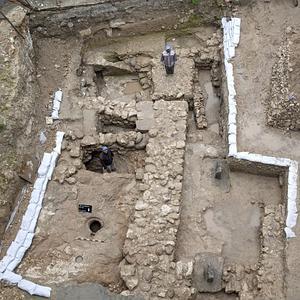One of the greatest accomplishments of open web-based platforms and social media is YouTube. It is one of my favorite places to investigate anything; repairing a dishwasher, where to vacation, and William Lane Craig debates, to name a few things (all I have done, mind you). A recent video (see here), I came across, involves a gentleman by the name of James Randi. Randi became famous for ‘debunking’ psyches and charlatans. “James Randi (born Randall James Hamilton Zwinge; August 7, 1928) is a Canadian-American retired stage magician and a scientific skeptic who has extensively challenged paranormal and pseudoscientific claims. Randi is the co-founder of the Committee for Skeptical Inquiry (CSI).”[i] I’ve watched numerous videos of Randi exposing those that claim psyche abilities or other supernatural claims. His expertise in ‘magic’ serves him greatly as he knows many of the slight-of-hand tricks and other ‘magic’ tricks.
Sadly, Randi seems to display a great affinity against ANY idea of the supernatural, including the idea of Jesus and the claims of the Bible. The video I came across deals with the ‘myth’ of Nazareth. The title of the video is “James Randi Debunks Jesus’ Hometown – Nazareth.”[ii] In it he claims, “Nazareth maybe overrated as an historical site that proves the inerrancy of the Bible.”[iii] He cites an author, René Salm, that wrote a book The Myth of Nazareth. Randi cites it numerous times within the video, an appeal to its findings, and wants to show how if Nazareth was a myth, Jesus was as well.

I am going to look at a few problems with Randi’s ideas and claims (and by extension, Salm’s). I have an ally in my corner, an unlikely one at that. He actually deals DIRECTLY with the claims in Salm’s book. It may seem to be an unlikely ally, at best, as it is none other than: Bart Ehrman. Ehrman is one of the most renowned Biblical (especially the New Testament) scholars on the planet, but he is also agnostic towards Christianity, at best. But he pulls no punches, whether dealing with a Christian or Mythicist (someone that believes Jesus is a myth and Christianity is based on this myth). Let’s look at Randi’s claims.
BIRTH PLACE?

The first thing we notice, the first error if you will, is Randi claims, “the Bible has Jesus Christ being born of course,”[iv] in Nazareth. This error almost had me quit watching as any child, with a nursery level Sunday School education, knows Jesus was born in Bethlehem. This error may be inadvertent, but it is a significant error. To be generous, maybe Randi meant where Jesus was CONCEIVED, as the Bible plainly states, “And in the sixth month the angel Gabriel was sent from God unto a city of Galilee, named Nazareth, To a virgin espoused to a man whose name was Joseph, of the house of David; and the virgin’s name was Mary.”[v] Mary and her soon to be husband are said to be residents of this town named Nazareth. Yet, Mary did not give birth in Nazareth, but in Bethlehem, as the Bible states, “And Joseph also went up from Galilee, out of the city of Nazareth, into Judaea, unto the city of David, which is called Bethlehem; (because he was of the house and lineage of David:) To be taxed with Mary his espoused wife, being great with child. And so it was, that, while they were there, the days were accomplished that she should be delivered.”[vi]
This may not be a ‘BIG’ deal, to get this simple item wrong, but it is a pretty significant issue. Nazareth has nothing to do with Jesus’ birthplace.
NAZARETH A MYTH?

Randi states that Salm’s book shows that, “research shows that the rest of the material from Nazareth site dates well after the time of Jesus Christ there simply is no demonstrable evidence from the Nazareth site that dates to the time of Jesus Christ.”[vii] This is an interesting claim. So, is there NO evidence? First of all, does it matter if Nazareth even existed? Some don’t think so.
“The logic of this argument, which is sometimes advanced with considerable vehemence and force, appears to be that if Christians made up Jesus’ hometown, they probably made him up as well. I could dispose of this argument fairly easily by pointing out that it is irrelevant. If Jesus existed, as the evidence suggests, but Nazareth did not, as this assertion claims, then he merely came from somewhere else.”[viii]
Yeah, my ‘ally’ is RIGHT! Does it actually matter if Nazareth existed or not? If Jesus existed, whether Nazareth existed or not is irrelevant. In some ways, that Nazareth existed or not is of no bearing on whether Jesus rose from the dead or not. Though, there is some legitimize to the idea that the reliability of scripture is more at stake here than anything pertaining to Jesus’ existence, life, death, and His resurrection. I think that the question of Nazareth, a real place or not, is probably of some importance.
So, did Nazareth exist? The previously mentioned book, The Myth of Nazareth, is something Ehrman is familiar with;
“Salm’s basic argument is that Nazareth did exist in more ancient times and through the Bronze Age. But then there was a hiatus. It ceased to exist and did not exist in Jesus’ day. Based on archaeological evidence, especially the tombs found in the area, Salm claims that the town came to be re-inhabited sometime between the two Jewish revolts (i.e., between 70 CE and 132 CE), as Jews who resettled following the destruction of Jerusalem by the Romans relocated in northern climes.”[ix]
That there is a ‘Nazareth’ is Salm’s finding, but that it ceased to exist at the time of Jesus is the basic premise. Others dispute this claim. Interestingly, Ehrman also reveals that Salm is no ‘expert’.
“Salm himself is not an archaeologist: he is not trained in the highly technical field of archaeology and gives no indication that he has even ever been on an archaeological dig. He certainly never has worked at the site of Nazareth. Still, he bases almost his entire case on archaeological reports about the town of Nazareth.”[x]
This is quite revealing, and Randi never mentions this in his video. He states, “a book that effectively demonstrates the controversial archaeology of the town,”[xi] demonstrates evidence that the ‘myth’ of Nazareth is the case. Salm has done no archeological research to prove his thesis, as Ehrman has shown. Have there been others that have?
“There are numerous compelling pieces of archaeological evidence that in fact Nazareth did exist in Jesus’ day, and that like other villages and towns in that part of Galilee, it was built on the hillside, near where the later rock-cut kokh tombs were built. For one thing, archaeologists have excavated a farm connected with the village, and it dates to the time of Jesus. Salm disputes the finding of the archaeologists who did the excavation (it needs to be remembered, he himself is not an archaeologist but is simply basing his views on what the real archaeologists – all of whom disagree with him — have to say). For one thing, when archaeologist Yardena Alexandre indicated that 165 coins were found in this excavation, she specified in the report that some of them were late, from the fourteenth or fifteenth centuries. This suits Salm’s purposes just fine. But as it turns out, there were among the coins some that date to the Hellenistic, Hasmonean, and early Roman period, that is, the days of Jesus. Salm objected that this was not in Alexandre’s report, but Alexandre has verbally confirmed (to me personally) that in fact it is the case: there were coins in the collection that date to the time prior to the Jewish uprising.”[xii]
Seems to me Salm entire argument(s) are based on what others have done in archeological findings, and simply comes down to ‘nah, that ain’t what it means fallacy’ (I made that one up, but it is pretty good-I must say).
2009

What does the year 2009 have to do with a 1st Century town called Nazareth?
“Until a few years ago, the only archaeological evidence for Nazareth amounted to little more than the remains of a winepress, a few tombs and a few artefacts. However in December 2009, the Israel Antiquities Authority issued a press release announcing that a house in Nazareth had now been excavated and had been found to contain artefacts from the “early Roman period” (first and second centuries). The archaeologists also found a pit hewn out of stone with a concealed entrance, which they believe was constructed as protection during the Jewish revolt of 67 CE.”[xiii]
A press release by the Israel Antiquities Authority from that amazing discovery is very telling.
“According to Yardenna Alexandre, excavation director on behalf of the Israel Antiquities Authority, “The discovery is of the utmost importance since it reveals for the very first time a house from the Jewish village of Nazareth and thereby sheds light on the way of life at the time of Jesus. The building that we found is small and modest and it is most likely typical of the dwellings in Nazareth in that period. From the few written sources that there are, we know that in the first century CE Nazareth was a small Jewish village, located inside a valley. Until now a number of tombs from the time of Jesus were found in Nazareth; however, no settlement remains have been discovered that are attributed to this period”.”[xiv]
According to the Israel Antiquities website, Nazareth is still being researched by a group of archeologists, namely; Freund Richard of the University of Hartford, Derawsha Maha of the University of Hartford, and Yanklevitz Shalom of the Haifa University, The Recanati Center for Maritime Studies.[xv] This is an active dig under permit #G-69, and new discoveries may be on the horizon that strengthen the claim of an ancient Nazareth, active in Jesus’ day. Of course Salm disputes the evidence;
“It deals with the highly-publicized “house from the time of Jesus” which made headlines just before Christmas, 2009. Typically, no evidence dating to the turn of the era (“time of Jesus”) has been forthcoming. In addition, the small excavation site was quickly covered up, so that no subsequent investigation is possible. A recently-opened pilgrim center now rises on the site, known as the Mary of Nazareth International Center—with boutique, restaurant, and theatre!””[xvi]
Salm is just plain wrong on every count. The Nazareth dig is active, not “covered up” as he claims. Arcehologist that have been at the site (Yardenna Alexandre) disagree that there is “no evidence” from the 1st Century Nazareth. Again, just some ‘nah, that ain’t what it means fallacy’ going on, it seems.
Conclusion
Mythicist are a strange group. Any evidence that points to the historical claims of the Bible or about Jesus are dismissed as fantastical, just out-of-hand, or ‘nah, that ain’t what it means fallacy’. Randi and Salm want us to think that Nazareth is a myth created by the earliest Christian’s as the hometown of Jesus. Why would they need to invent a town? Why Nazareth, that even Salm admits existed PRIOR to Jesus and after? These are claims that have no basis, at least as they have argued.
“As it turns out, another discovery was made in ancient Nazareth, a year after Salm’s book appeared. It is a house that dates to the days of Jesus. Again the principal archaeologist was Yardena Alexandre, the excavations director at the Israel Antiquity Authority, whom I again wrote. She has confirmed the news report. The house is located on the hill slopes. Pottery remains connected to the house range from roughly 100 BCE to 100 CE (i.e., the days of Jesus). There is nothing in the house to suggest that the persons inhabiting it over this time had any wealth: there is no glass and no imported products. The vessels are made of clay and chalk.
The AP story concludes that “the dwelling and older discoveries of nearby tombs in burial caves suggest that Nazareth was an out-of the-way hamlet of around 50 houses on a patch of about four acres… populated by Jews of modest means.” No wonder this place is never mentioned in the Hebrew Bible, Josephus, or the Talmud. It was far too small, poor, and insignificant. Most people had never heard of it and those who had heard didn’t care. Even though it existed, this is not the place someone would make up as the hometown of the Messiah. Jesus really came from there, as attested in multiple sources.”[xvii]
This seems to fit well with what one said, as he was introduced to this ‘Jesus of NAZARETH’… ““Nazareth!” exclaimed Nathanael. “Can anything good come from Nazareth?” “Come and see for yourself,” Philip replied.”[xviii]
[i] <https://en.wikipedia.org/wiki/James_Randi>
[ii] <https://www.youtube.com/watch?v=hCQVrhgCwAQ)>
[iii] Ibid (transcript-00:03-00:05 mark-as provided)
[iv] Ibid (transcript-00:20 mark)
[v] Luke 1:26-27 (KJV)
[vi] Luke 2:4-6 (KJV)
[vii] <https://www.youtube.com/watch?v=hCQVrhgCwAQ)> (transcript-02:54-03:06)
[viii] Ehrman, Bert ‘Did Nazareth Exist’ <https://ehrmanblog.org/did-nazareth-exist/>
[ix] Ibid
[x] Ibid
[xi] <https://www.youtube.com/watch?v=hCQVrhgCwAQ)>(transcript-00:14-00:15-mark)
[xii] Ehrman ‘Did Nazareth Exist’
[xiii] ‘Did Bethlehem and Nazareth Exist in Jesus’ Day?’<https://www.is-there-a-god.info/blog/belief/did-bethlehem-and-nazareth-exist-in-jesus-day/>
[xiv] ‘For the Very First Time: A Residential Building from the Time of Jesus was Exposed in the Heart of Nazareth (12/21/09)’ <http://www.antiquities.org.il/article_eng.aspx?sec_id=25&subj_id=240&id=1638&module_id=#as>
[xv] <http://www.antiquities.org.il/Active_Digs_eng.aspx>
[xvi] <http://www.nazarethmyth.info/bibl.html>
[xvii] Ehrman, “Did Nazareth Exist’
[xviii] John 1:46 (NLT2)
1 thought on “Nazareth: Fact or Fiction?”